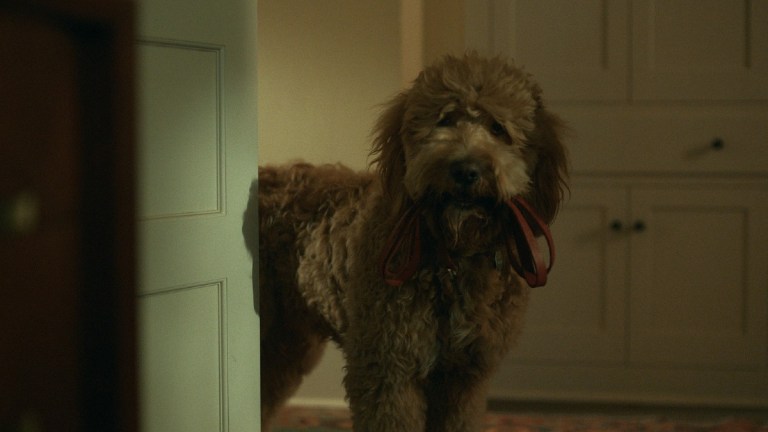Lessons in Chemistry Leaves Six-Thirty Fans in the Doghouse
Lessons in Chemistry can't commit to the bit when it comes to the very good boy Six-Thirty.

This article contains spoilers for Lessons in Chemistry through episode 4.
There’s no disputing that Six-Thirty is the very best boi. All dogs are the very best dogs. And Six-Thirty is no exception. In Lessons in Chemistry — both the novel and the Apple TV+ series — Six-Thirty is a thoughtful, protective stray who loves his family fiercely and is treated like an equal in return. Author Bonnie Garmus originally brought the pup to life on the page, handing over a hefty portion of the narrative duties to Elizabeth Zott’s best friend.
In a fantastical bit of storytelling, Garmus asks readers to believe that Elizabeth is able to successfully teach Six-Thirty to recognize nearly a thousand distinct words. So when we reach passages that feature his inner monologue, it feels like a really intelligent dog is talking directly to us. While this concept requires some suspension of disbelief, Garmus does an effective job of making us love Six-Thirty like our very own doggo through weaving in heart-on-sleeve emotion and moments of sweet naivete that we all adore in our canine companions.
It was always going to be a challenge to translate such a conceit from page to screen. However, as a huge fan of Six-Thirty, I was excited to see what they might do with his character. At first, it appeared as if the shaggy dude was going to be one of the main characters of the show: he featured prominently on the poster for the series, in fact, he’s the only other character other than Elizabeth to feature in the poster at all. It felt like he was destined for something big.
And then the first two episodes premiered, and other than some knowing cuts to a cute, tilty-headed mutt, we didn’t get much. Okay, I thought, they’re going to go the silent route with the dog. It’s a bummer, but okay. But then! In episode 3, the camera focuses on Six-Thirty’s attentive face, and he starts to speak. Reader, I must admit that I burst into tears with excitement. I was overjoyed that my sweet guy was being given a chance to tell his side of the story.
Tenderly voiced by The Office alum B.J. Novak, Six-Thirty’s thoughts were a welcome addition. To me, someone who read the book, it felt like all the players were now on the board, and the fact that they introduced the dog’s voice in the immediate aftermath of Calvin’s death made it feel like the show was striving for some sort of emotional balance. Given that the entirety of episode 3 didn’t fully focus on Six-Thirty, I didn’t think that the show would unceremoniously abandon his inner monologue after a single, unfocused episode. But that’s exactly what they did.
Was a faithful on-screen adaptation of Six-Thirty always doomed to fail? There are certainly limits to translating any rich inner monologue from page-to-screen, much less the rich inner monologue of a character who literally cannot speak. It honestly would have been understandable (if disappointing) if the show had abandoned the concept altogether in favor of knowing cuts to an adorable dog. Therefore, it feels odd that showrunner Lee Eisenberg would decide to pull a bait-and-switch on fans of the novel, giving them hope that their favorite pooch might be by their side throughout the duration of the series, only to unleash the concept after a single episode. Perhaps Eisenberg and his team decided that giving Six-Thirty his moment in the sun would appease fans of the book just enough while not making it weird or inaccessible for non-readers.
Unfortunately, this approach only serves to split the difference and cause confusion for both parties. (The prominent TV critic Alan Sepinwall has gone on record saying that he felt this episode was “utterly ridiculous,” but a colleague of his loved it. Sepinwall didn’t read the book, but I’d bet money that his colleague did.) Honestly, B.J. Novak is pretty great as Six-Thirty, and, as the fourth episode illustrates, the show continues to cut to the dog to punctuate pivotal moments anyway — so why not continue to pepper in some pupper?
Cutting off Six-Thirty’s narrative duties is insulting enough, but the series does this dog dirty in other ways as well. Very few book adaptations are faithfully translated from the text, but there are a few changes to Six-Thirty that seem unnecessary, cruel, and unnecessary cruel. First up? Why on earth did the show decide to change Six-Thirty’s namesake? In the novel, Six-Thirty is named after an innocent and adorable misunderstanding between Calvin and Elizabeth in which Elizabeth isn’t even aware that the pup is following her home.
“Who’s your friend?” he called out to her, shaking off the odd feeling.
“It’s six thirty.” she called back after glancing at her wrist.
In the show, however, he’s named for the time at which he wakes Elizabeth up in the morning. How boring. I almost fell asleep writing that sentence, it’s so boring. If I named my dog after the time he woke me up, his name would be “He-Who-Sleeps-In-Until-I-Smooch-Him-Awake.” That name is more descriptive and it’s still boring. Six-Thirty would hate it.
The most egregious slight toward Six-Thirty is his involvement in Calvin’s untimely death. In the book, his death is a tragic accident. Six-Thirty and Calvin have been running buddies for some time when Elizabeth buys the dog a leash in order to comply with the city’s new leash laws. When Six-Thirty wears the leash for the first time, he and Calvin both become disoriented at an inopportune time, resulting in the man’s death. In the show, things are different. The first time Six-Thirty wears the leash Elizabeth buys, it’s the first time he goes running with Calvin. And Calvin hasn’t really taken the time to train him properly. So when Six-Thirty balks at going into the road, Calvin doesn’t know what to do. He stands in the middle of the busy street, like a dummy, yanking at the dog’s lead, when he’s hit by oncoming traffic. Due to this misunderstanding, the show makes it look like the obstinate dog is responsible for Calvin’s death. Eventually, we get a roundabout explanation from Six-Thirty, but it’s never enough to absolve him of his guilt.
In both the novel and the series, Elizabeth never once blames Six-Thirty for Calvin’s death. (Instead, she blames herself.) However, the way in which it’s depicted in the show paints Six-Thirty as a bad dog, and we know that just isn’t true. And without a consistent voice with which to defend himself, our furry friend simply becomes relegated to the sidelines for the remainder of the story. I’d cry out for justice for Six-Thirty, but thankfully justice is just a page turn away. In the case of the missing dog dialogue, it can be found in the original source material. For fans who are currently watching the TV series and wish to hear more from Six-Thirty, simply heed the words of LeVar Burton, Elizabeth Zott’s fellow public-access superstar: take a look, it’s in a book.
New episodes of Lessons in Chemistry premiere Fridays on Apple TV+, culminating with the finale on Nov. 24.
